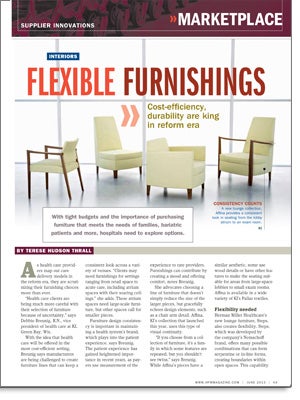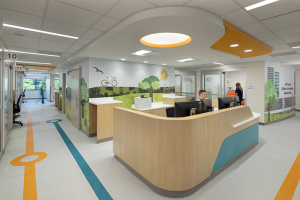Flexible furnishings

As health care providers map out care delivery models in the reform era, they are scrutinizing their furnishing choices more than ever.
"Health care clients are being much more careful with their selection of furniture because of uncertainty," says Debbie Breunig, R.N., vice president of health care at KI, Green Bay, Wis.
With the idea that health care will be offered in the most cost-efficient setting, Breunig says manufacturers are being challenged to create furniture lines that can keep a consistent look across a variety of venues. "Clients may need furnishings for settings ranging from retail space to acute care, including atrium spaces with their soaring ceilings," she adds. These atrium spaces need large-scale furniture, but other spaces call for smaller pieces.
Furniture design consistency is important in maintaining a health system's brand, which plays into the patient experience, says Breunig. The patient experience has gained heightened importance in recent years, as payers use measurement of the experience to rate providers. Furnishings can contribute by creating a mood and offering comfort, notes Breunig.
She advocates choosing a line of furniture that doesn't simply reduce the size of the larger pieces, but gracefully echoes design elements, such as a chair arm detail. Affina, KI's collection that launched this year, uses this type of visual continuity.
"If you choose from a collection of furniture, it's a family in which some features are repeated, but you shouldn't see twins," says Breunig. While Affina's pieces have a similar aesthetic, some use wood details or have other features to make the seating suitable for areas from large-space lobbies to small exam rooms. Affina is available in a wide variety of KI's Pallas textiles.
Flexibility needed
Herman Miller Healthcare's new lounge furniture, Steps, also creates flexibility. Steps, which was developed by the company's Nemschoff brand, offers many possible combinations that can form serpentine or in-line forms, creating boundaries within open spaces. This capability also can be used to direct the flow of visitors. "It creates areas of privacy and openness by having the chair backs at different heights," notes Dave Simon, vice president and creative director for Herman Miller Healthcare, Zeeland, Mich. "It's a human-centered line of furniture that is responsive to the emotional needs of visitors."
Flexibility also can be seen on a smaller scale — with one piece of furniture being able to be used in several settings. Lauri Waidner, director of marketing at Champion Manufacturing Inc., Elkhart, Ind., notes that its Continuum recliner can be used for patients in multiple treatment settings, such as cancer infusion therapy and dialysis, as well as serving as a patient room recliner.
She adds that the recliner also can be positioned flat for a sleeping surface, without staff assistance, so patients can receive therapy at any time, day or night. The recliner's lever-release footrest is reflective of a home recliner, giving patients a familiar feel. "It brings home into the medical facility," says Waidner.
One more way designers can use flexibility is by selecting a piece of furniture that serves several purposes. The sleepToo is a sleep sofa that addresses the space constraints of the patient room, while incorporating a cantilevered table. This creates a place for families to rest, work, eat, play games or sleep in 20 square feet. "It's a virtual family room," says Kim Sank, marketing manager for Wieland, Grabill, Ind.
The sofa is available in several models that can be customized with ottomans, arm-cap types, leg styles and drawers made from wood, fabric or thermoform.
Hospitality look, health care durability
Another challenge facing furniture manufacturers is the ability to produce a product with a high-end look that is durable and can withstand hospital cleanings. "Manufacturers are paying more attention to bringing those aspects together," says Jocelyn Stroupe, AAHID, IIDA, ASID, EDAC, principal and health care interiors design practice leader, Cannon Design, Chicago. "Hospitals are back to bleach because certain pathogens can't be killed without it. Nearly any product can be disinfected, but upholstery is the toughest part to clean."
Vendors mention a number of ways they are addressing the cleanability issue. KI's Pallas Textiles have a number of seat coverings that are "bleach-friendly," says Breunig. "They are breathable and feel good to touch, so patients will find them similar to the seating they have in their homes."
Manufacturers also are working to provide attractive hard surfaces that can be disinfected. Nemschoff has developed a proprietary wood seal for just that purpose. Simon notes that Herman Miller Healthcare is using Corian in its furnishings because it has a residential feel, but is not porous and, thus, can be disinfected. "Having furniture with a high-end look that can withstand hospital cleanings is a pervasive design challenge," he adds, but one that creative designers can meet.
For instance, Northland Furniture makes casework from engineered wood laminate. "It has the appearance of a wood grain and feels like wood if you touch it," says Mark Kramer, marketing and sales manager for Northland Furniture, Bend, Ore., "but it is a lot easier to clean." He notes that improvements to laminate's quality in the last five years have made such a product possible. "We are always balancing the look, durability and cost," he adds.
Functionality is also an important consideration. For instance, on the nightstand Northland produced recently for a health care facility, the manufacturer customized the top drawer to include a tray for nurses to store medicines and a drinking cup. This allows nurses to save time when they come in to give medicines — they can simply take it out of the nightstand, put it on the over-the-bed table and then put it back. This kind of request is not unusual, says Kramer. "We have our standard lines, but 80 to 90 percent of the time we end up customizing pieces."
Bariatric capability and sustainability
Ongoing trends include furniture for bariatric patients and furnishings that support the sustainability movement. "Bariatric furniture is standard now," says Stroupe, adding that many of her clients want 10 percent of seating and 10 percent of exam rooms to accommodate bariatric patients. As evidence of the continuing demand, Breunig notes that all of KI's lounge chairs are tested to support 750 pounds. Designers want to "weave in" these kinds of pieces, she says, which are wider than a standard chair. "This chair can look like a settee and fit with the other pieces," says Breunig. "It shouldn't scream out that it's a piece of furniture for the size-challenged."
Stroupe notes that she's seeing more furniture made with recycled content, adding that furniture can be part of the LEED credit. Many vendors continue to offer field replaceable components, one way to keep furniture out of landfills.
New York City-based Humanscale's Diffrient Smart chair, a task chair that provides lower lumbar support without manual adjustment, also was designed to stay out of landfills. Its materials are reusable and it has fewer parts than other chairs in its class, so fewer materials are used in its production.
Technology trends
Accommodating technology is another aspect that furniture designers must consider. "At the time we are designing a facility, we are not sure — by the time the facility is in operation — how staff will use technology or what that technology will be," says Stroupe. "It's a moving target."
Stroupe adds that facilities currently designate a variety of spaces where staff can use technology: patient rooms, hallway alcoves and nursing stations.
Each of these areas calls for ergonomic solutions, allowing staff to comfortably use a computer or tablet. Some hospitals use movable carts for computer monitors, but even those may fade as clinical staff simply carry some type of handheld equipment.
Herman Miller Healthcare's Ethospace nursing station furniture can fit any spaces — large or small — and its modular design provides the flexibility to accommodate various types of technology. With many adjustable surfaces, storage options and configurable walls, Ethospace can facilitate the technology needs of a unit secretary's long-term seated work and a nurse's on-the-move, stand-up work.
Of course, technology isn't just used by staff. Regard, a new lounge furniture line from Nurture by Steelcase, Grand Rapids, Mich., integrates technology with seating for visitors. "Regard empowers users," says Jason Vanderground, Nurture marketing communications manager. Visitors can view a medical video at a kiosk, charge their smartphone on built-in stations, catch up on work with a laptop, or even relax by watching TV or using a gaming system. "Furniture needs to start doing more to create the spaces health care facilities need," says Vanderground.
Although health care facilities face uncertainty, they will continue to serve patients, and that often means updating interiors and buying furnishings for new facilities. "For health care providers facing questions about the future, we bring forward the most flexible, adaptable solutions we can," Stroupe says.
Terese Hudson Thrall is a freelance writer based in the Chicago area and former associate editor for Health Facilities Management.
| Sidebar - For more information |
| For further details on the furnishings featured in this month's Marketplace article, readers can contact the following vendors: »Champion Manufacturing »Herman Miller »Humanscale »KI »Northland Furniture »Nurture by Steelcase »Weiland |




